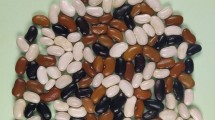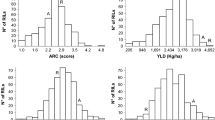Abstract
Seed coat colour is an important agronomic trait in adzuki bean (Vigna angularis). Here, we identified four genes controlling seed coat colour in this species. We conducted a quantitative trait locus (QTL) study of 133 recombinant inbred lines (F6) derived from a cross between V. angularis Shumari (red) and landrace Acc2265 (olive buff), by using simple sequence repeat (SSR) markers. We identified a strong QTL, designated OLB1, which explained 54, 43, and 56 % of the total variance in the L* (lightness), a* (redness), and b* (yellowness) values, respectively. In addition, we identified a minor QTL, designated OLB2, which explained 6 % of the total variance in redness. OLB1 and OLB2 were located on linkage group (LG) 1, >80 cM apart. The F1 phenotype was olive buff, implying that the red colour trait was recessive. Next, we crossed two spontaneous mutants, ‘Shiro-shouzu’ (ivory yellow) and ‘TA230002’ (pale olive buff), to the red-seeded ‘Beni-shouzu’. Genetic analysis of the F1, F2, and F3 progenies derived from each parental cross revealed that the ivory yellow and pale olive buff traits were recessive to the red trait. Molecular mapping studies indicated that the ivory yellow trait was controlled by a single Mendelian gene, designated IVY, located on LG 8. The pale olive buff trait was also controlled by a single Mendelian gene, designated POB, located on LG 10. Our findings will facilitate the development of novel red seed cultivars and the introgression of ivory yellow genes into desirable cultivars, via marker-assisted selection.




Similar content being viewed by others
References
Ariga T, Hamano M (1990) Radical scavenging action and its mode in procyanidins B-1, and B-3 from azuki beans to peroxyl radicals. Agric Biol Chem 54:2499–2504. doi:10.1271/bbb1961.54.2499
Ariga T, Koshiyama I, Fukushima D (1988) Antioxidative properties of procyanidins B-1 and B-3 from azuki beans in aqueous system. Agric Biol Chem 52:2717–2722. doi:10.1271/bbb1961.52.2717
Buckow R, Kastell A, Terefe NS, Versteeg C (2010) Pressure and temperature effects on degradation kinetics and storage stability of total anthocyanins in blueberry juice. J Agric Food Chem 58:10076–10084. doi:10.1021/jf1015347
Han OK, Kaga A, Isemura T, Wang XW, Tomooka N, Vaughan DA (2005) A genetic linkage map for azuki bean [Vigna angularis (Willd.) Ohwi & Ohashi]. Theor Appl Genet 111:1278–1287
Isemura T, Kaga A, Konishi S, Ando T, Tomooka N, Han OK, Vaughan DA (2007) Genome dissection of traits related to domestication in azuki bean (Vigna angularis) and comparison with other warm-season legumes. Ann Bot 100:1053–1071. doi:10.1093/aob/mcm155
Kaga A, Isemura T, Tomooka N, Vaughan DA (2008) The genetics of domestication of the azuki bean (Vigna angularis). Genetics 178:1013–1036. doi:10.1534/genetics.107.078451
Kosambi DD (1944) The estimation of map distance from recombination values. Ann Eugen 12:172–175
Lumpkin TA, McClary DC (1994) Azuki bean: botany, production and uses. CAB International, Wallingford
Parida A, Raina SN, Narayan RKJ (1990) Quantitative DNA variation between and within chromosome complements of Vigna species (Fabaceae). Genetica 82:125–133
Patras A, Brunton NP, O’Donnell C, Tiwari BK (2010) Effect of thermal processing on anthocyanin stability in foods; mechanisms and kinetics of degradation. Trends Food Sci Technol 21:3–11
Sasanuma S, Takeda K, Hayashi K (1996) Black red pigment of “adzuki bean” studies on anthocyanins LV. Bot Mag Tokyo 79:807–810
Sato S, Yamate J, Hori Y, Hatai A, Nozawa M, Sagai M (2005) Protective effect of polyphenol-containing azuki bean (Vigna angularis) seed coats on the renal cortex in streptozotocin-induced diabetic rats. J Nutr Bioch 16:547–553. doi:10.1016/j.jnutbio.2005.02.003
Schuelke M (2000) An economic method for fluorescent labeling of PCR fragments. Nat Biotech 18:233–234. doi:10.1038/72708
Suzuki T, Sato M, Takeuchi T (2012) Evaluation of the effects of five QTL regions on Fusarium head blight resistance and agronomic traits in spring wheat (Triticum aestivum L.). Breed Sci 62:11–17. doi:10.1270/jsbbs.62.11
Takahama U, Yamauchi R, Hirota S (2013) Isolation and characterization of a cyanidin-catechin pigment from adzuki bean (Vigna angularis). Food Chem 141:282–288. doi:10.1016/j.foodchem.2013.02.113
Takahashi Y, Fukuyama J (1917) Morphological and genetic studies on the Adzuki-bean. Hokkido Agricultural Experiment Station report no. 7. Hokkaido Agricultural Experiment Station, Sapporo, Japan
Van Ooijen JW (2009) MapQTL® 4, software for the mapping of quantitative trait loci in experimental populations of diploid species. Kyazma BV, Wageningen
Vaughan DA, Tomooka N, Kaga A (2005) Azuki bean [Vigna angularis (L.) Ohwi and Ohashi]. In: Singh RJ, Jauhar PP (eds) Genetic resources, chromosome engineering, and crop improvement. Grain legumes, vol 1. CRC Press, Boca Roca, pp 341–353
Yamada T, Teraishi M, Hattori K, Ishimoto M (2001) Transformation of azuki bean by Agrobacterium tumefaciens. Plant Cell Tissue Organ Cult 64:47–54
Yoshida K, Sato Y, Okuno R, Kameda K, Isobe M, Kondo T (1996) Structural analysis and measurement of anthocyanins from colored seed coats of Vigna, Phaseolus, and Glycine legumes. Biosci Biotechnol Biosci 60:589–593
Acknowledgments
We thank Tokachi Agricultural Cooperative Associations and the Hokkaido College of Agriculture for providing the original seeds of ‘TA230002’ and ‘Shiro-shouzu’, respectively.
Conflict of interest
The authors declare that they have no conflict of interest.
Funding
This study was funded by the Japan Beans Fund Association and the Obihiro University of Agriculture and Veterinary Medicine (10089).
Author information
Authors and Affiliations
Corresponding author
Electronic supplementary material
Below is the link to the electronic supplementary material.
10681_2015_1461_MOESM1_ESM.pptx
Supplementary material 1 (PPTX 1042 kb). F3 seeds of a cross between adzuki bean (Vigna angularis) cultivars ‘Shumari’ (red) and Acc2265 (olive buff)
Rights and permissions
About this article
Cite this article
Horiuchi, Y., Yamamoto, H., Ogura, R. et al. Genetic analysis and molecular mapping of genes controlling seed coat colour in adzuki bean (Vigna angularis). Euphytica 206, 609–617 (2015). https://doi.org/10.1007/s10681-015-1461-9
Received:
Accepted:
Published:
Issue Date:
DOI: https://doi.org/10.1007/s10681-015-1461-9




